Development of a Multifunctional Edible Coating and Its Preservation Effect on Sturgeon (Acipenser baeri♀× Acipenser schrenckii♂) Fillets during Refrigerated Storage at 4 °C
Abstract
:1. Introduction
2. Materials and Methods
2.1. Materials
2.2. Preparation of Coating Solution
2.3. Sample Treatment and Storage
2.4. Rheological Properties of the Coating Solution
2.5. Antimicrobial Evaluation of Coating Solution
2.6. Scanning Electron Microscopy (SEM)
2.7. X-ray Diffraction (XRD)
2.8. Film Physical Properties
2.8.1. Film Thickness
2.8.2. Swelling Capacity
2.8.3. Water Solubility
2.8.4. Light Transmittance
2.8.5. Water Vapor Transmission Rate (WVTR)
2.9. Microbiological Analysis
2.10. Sensory Evaluation
2.11. Determination of pH and TVB-N
2.12. Determination of K-Value
2.13. Thiobarbituric Acid (TBA) and SDS-PAGE Analysis
2.14. Statistical Analyses
3. Results and Discussion
3.1. Properties of the Coating Solution
3.2. Characterization of the Films
3.3. Assessment of Microbial Spoilage in Sturgeon Fillets
3.4. Changes in Quality and Biochemistry of Sturgeon Fillets
3.4.1. Sensory Evaluation
3.4.2. Changes in pH, TVB-N, and K-Value
3.4.3. Changes in TBA
3.4.4. SDS-PAGE Analysis
4. Conclusions
Supplementary Materials
Author Contributions
Funding
Institutional Review Board Statement
Informed Consent Statement
Data Availability Statement
Conflicts of Interest
References
- Gui, M.; Zhao, B.; Song, J.; Zhang, Z.; Hui, P.; Li, P. Biogenic amines formation, nucleotide degradation and TVB-N accumulation of vacuum-packed minced sturgeon (Acipenser schrencki) stored at 4 °C and their relation to microbiological attributes. J. Sci. Food Agric. 2014, 94, 2057–2063. [Google Scholar] [CrossRef] [PubMed]
- Chen, Y.; Cai, W.; Shi, Y.; Dong, X.; Bai, F.; Shen, S.; Jiao, R.; Zhang, X.; Zhu, X. Effects of different salt concentrations and vacuum packaging on the shelf-stability of Russian sturgeon (Acipenser gueldenstaedti) stored at 4 °C. Food Control 2020, 109, 106865. [Google Scholar] [CrossRef]
- Vaccaro, A.M.; Buffa, G.; Messina, C.M.; Santulli, A.; Mazzola, A. Fatty acid composition of a cultured sturgeon hybrid (Acipenser naccarii × A. baerii). Food Chem. 2005, 93, 627–631. [Google Scholar] [CrossRef]
- Yu, D.; Jiang, Q.; Xu, Y.; Xia, W. The shelf life extension of refrigerated grass carp (Ctenopharyngodon idellus) fillets by chitosan coating combined with glycerol monolaurate. Int. J. Biol. Macromol. 2017, 101, 448–454. [Google Scholar] [CrossRef] [PubMed]
- Yu, M.; Gang, K.; Li, C.; Wang, J.; Liu, Y.; Zhou, D.; Zhu, B. Change of lipids in whelks (Neptunea arthritica cumingi Crosse and Neverita didyma) during cold storage. Food Res. Int. 2020, 136, 109330. [Google Scholar] [CrossRef] [PubMed]
- Lyu, J.; Li, Q.; Zhang, L.; Zhang, J.; Dong, Z.; Feng, L.; Luo, Y. Changes in quality of rainbow trout (Oncorhynchus mykiss) fillets preserved with salt and sugar at low concentrations and stored at 4 °C. Int. J. Food Prop. 2017, 20, 2286–2298. [Google Scholar] [CrossRef] [Green Version]
- Odeyemi, O.A.; Burke, C.M.; Bolch, C.C.; Stanley, R. Seafood spoilage microbiota and associated volatile organic compounds at different storage temperatures and packaging conditions. Int. J. Food Microbiol. 2018, 280, 87–99. [Google Scholar] [CrossRef]
- Olatunde, O.O.; Benjakul, S. Natural preservatives for extending the shelf-life of seafood: A revisit. Compr. Rev. Food Sci. Food Saf. 2018, 17, 1595–1612. [Google Scholar] [CrossRef] [Green Version]
- Jia, S.; Li, Y.; Zhuang, S.; Sun, X.; Zhang, L.; Shi, J.; Hong, H.; Luo, Y. Biochemical changes induced by dominant bacteria in chill-stored silver carp (Hypophthalmichthys molitrix) and GC-IMS identification of volatile organic compounds. Food Microbiol. 2019, 84, 103248. [Google Scholar] [CrossRef]
- Lu, H.; Zhang, L.; Shi, J.; Wang, Z.; Luo, Y. Effects of frozen storage on physicochemical characteristics of bighead carp (Aristichthys nobilis) fillets. J. Food Process. Pres. 2019, 43, e14141. [Google Scholar] [CrossRef]
- Jia, S.; Liu, Y.; Zhuang, S.; Sun, X.; Li, Y.; Hong, H.; Lv, Y.; Luo, Y. Effect of ε-polylysine and ice storage on microbiota composition and quality of Pacific white shrimp (Litopenaeus vannamei) stored at 0 °C. Food Microbiol. 2019, 83, 27–35. [Google Scholar] [CrossRef]
- Sørensen, J.S.; Bøknæs, N.; Mejlholm, O.; Dalgaard, P. Superchilling in combination with modified atmosphere packaging resulted in long shelf-life and limited microbial growth in Atlantic cod (Gadus morhua L.) from capture-based aquaculture in Greenland. Food Microbiol. 2020, 88, 103405. [Google Scholar] [CrossRef] [PubMed]
- Wei, Q.; Wang, X.; Sun, D.W.; Pu, H. Rapid detection and control of psychrotrophic microorganisms in cold storage foods: A review. Trends Food Sci. Technol. 2019, 86, 453–464. [Google Scholar] [CrossRef]
- Doulgeraki, A.I.; Ercolini, D.; Villani, F.; Nychas, G.J.E. Spoilage microbiota associated to the storage of raw meat in different conditions. Int. J. Food Microbiol. 2012, 157, 130–141. [Google Scholar] [CrossRef]
- Valerie, D.J.; An, C.; Koenraad, V.H.; Winy, M.; Anita, V.L.; Paul, D.V.; Marc, H. Influence of storage conditions on the growth of Pseudomonas species in refrigerated raw milk. Appl. Environ. Microb. 2011, 77, 460–470. [Google Scholar]
- Dai, W.; Gu, S.; Xu, M.; Wang, W.; Yao, H.; Zhou, X.; Ding, Y. The effect of tea polyphenols on biogenic amines and free amino acids in bighead carp (Aristichthys nobilis) fillets during frozen storage. LWT-Food Sci. Technol. 2021, 150, 111933. [Google Scholar] [CrossRef]
- Yu, D.; Xu, Y.; Regenstein, J.M.; Xia, W.; Yang, F.; Jiang, Q.; Wang, B. The effects of edible chitosan-based coatings on flavor quality of raw grass carp (Ctenopharyngodon idellus) fillets during refrigerated storage. Food Chem. 2018, 242, 412–420. [Google Scholar] [CrossRef] [PubMed]
- Falah, F.; Shirani, K.; Vasiee, A.; Yazdi, F.T.; Behbahani, B.A. In vitro screening of phytochemicals, antioxidant, antimicrobial, and cytotoxic activity of Echinops setifer extract. Biocatal. Agric. Biotechnol. 2021, 35, 102102. [Google Scholar] [CrossRef]
- Tan, C.; Han, F.; Zhang, S.; Li, P.; Shang, N. Novel bio-based materials and applications in antimicrobial food packaging: Recent advances and future trends. Int. J. Mol. Sci. 2021, 22, 9663. [Google Scholar] [CrossRef]
- Noshad, M. The impact of Qodume Shirazi seed mucilage-based edible coating containing lavender essential oil on the quality enhancement and shelf life improvement of fresh ostrich meat: An experimental and modeling study. Food Sci. Nutr. 2020, 8, 6497–6512. [Google Scholar]
- Behbahani, A.A.; Falah, F.; Vasiee, A.; Yazdi, F.T. Control of microbial growth and lipid oxidation in beef using a Lepidium perfoliatum seed mucilage edible coating incorporated with chicory essential oil. Food Sci. Nutr. 2021, 9, 2458–2467. [Google Scholar] [CrossRef] [PubMed]
- Tan, C.; Xiao, M.; Wu, R.; Li, P.; Shang, N. Unraveling the effects of biochemical drivers on the bacterial communities and volatile profiles in refrigerated sturgeon fillets at 4 °C. Front. Microbiol. 2022, 13, 849236. [Google Scholar] [CrossRef] [PubMed]
- World Organisation for Animal Health. Welfare aspects of stunning and killing of farmed fish for human consumption. In Aquatic Animal Health Code; NHBS: Tullamarine, VIC, Australia, 2021; Available online: https://www.woah.org/fileadmin/Home/eng/Health_standards/aahc/2010/en_chapitre_welfare_stunning_killing.htm (accessed on 23 June 2021).
- Rong, L.; Shen, M.; Wen, H.; Xiao, W.; Li, J.; Xie, J. Eggshell powder improves the gel properties and microstructure of pea starch-Mesona chinensis Benth polysaccharide gels. Food Hydrocolloid. 2022, 125, 107375. [Google Scholar] [CrossRef]
- Li, Y.; Chen, K.; Yang, Q.; Hong, H.; Feng, L.; Luo, Y. Development and characterization of novel antioxidant films based on chitosan and Maillard reaction products. LWT-Food Sci. Technol. 2021, 141, 110886. [Google Scholar] [CrossRef]
- Gui, M.; Zhang, Y.; Gao, L.; Li, P. Effect of AHL-lactonase and nisin on microbiological, chemical and sensory quality of vacuum packaged sturgeon storage at 4 °C. Int. J. Food Prop. 2021, 24, 222–232. [Google Scholar] [CrossRef]
- Huang, Z.; Liu, X.; Jia, S.; Zhang, L.; Luo, Y. The effect of essential oils on microbial composition and quality of grass carp (Ctenopharyngodon idellus) fillets during chilled storage. Int. J. Food Microbiol. 2018, 266, 52–59. [Google Scholar] [CrossRef]
- Anbarani, N.M.; Razavi, S.M.A.; Taghizadeh, M. Impact of sage seed gum and whey protein concentrate on the functional properties and retrogradation behavior of native wheat starch gel. Food Hydrocolloid. 2021, 111, 106261. [Google Scholar] [CrossRef]
- Zeng, Q.; Zhang, L.; Liao, W.; Liu, J.; Yuan, F.; Gao, Y. Effect of xanthan gum co-extruded with OSA starch on its solubility and rheological properties. LWT-Food Sci. Technol. 2021, 147, 111588. [Google Scholar] [CrossRef]
- Xu, J.; Xia, R.; Yuan, T.; Sun, R. Use of xylooligosaccharides (XOS) in hemicelluloses/chitosan-based films reinforced by cellulose nanofiber: Effect on physicochemical properties. Food Chem. 2019, 298, 125041. [Google Scholar] [CrossRef]
- Xu, Y.; Liu, X.; Jiang, Q.; Yu, D.; Xu, Y.; Wang, B.; Xia, W. Development and properties of bacterial cellulose, curcumin, and chitosan composite biodegradable films for active packaging materials. Carbohyd. Polym. 2021, 260, 117778. [Google Scholar] [CrossRef]
- Jana, S.; Trivedi, M.K.; Tallapragada, R.M.; Branton, A.; Trivedi, D.; Nayak, G.; Mishra, R.K. Characterization of physicochemical and thermal properties of chitosan and sodium alginate after biofield treatment. Pharm. Anal. Acta 2015, 6, 1000430. [Google Scholar] [CrossRef] [Green Version]
- Mohan, C.; Ravishankar, C.; Srinivasa Gopal, T.; Lalitha, K.; Asok Kumar, K. Effect of reduced oxygen atmosphere and sodium acetate treatment on the microbial quality changes of seer fish (Scomberomorus commerson) steaks stored in ice. Food Microbiol. 2010, 27, 526–534. [Google Scholar] [CrossRef] [PubMed]
- Zhuang, S.; Liu, X.; Li, Y.; Zhang, L.; Hong, H.; Liu, J.; Luo, Y. Biochemical changes and amino acid deamination & decarboxylation activities of spoilage microbiota in chill-stored grass carp (Ctenopharyngodon idella) fillets. Food Chem. 2020, 336, 127683. [Google Scholar] [PubMed]
- Li, Y.; Zhuang, S.; Liu, Y.; Zhang, L.; Liu, X.; Cheng, H.; Liu, J.; Shu, R.; Luo, Y. Effect of grape seed extract on quality and microbiota community of container-cultured snakehead (Channa argus) fillets during chilled storage. Food Microbiol. 2020, 91, 103492. [Google Scholar] [CrossRef]
- Li, D.; Li, Q.; Zhang, Y.; Liu, X.; Hong, H.; Luo, Y. Quality changes and microbiological spoilage analysis of air-packed and vacuum-packed silver carp (Hypophthalmichthys molitrix) fillets during chilled storage. J. Food Process. Pres. 2018, 42, e13389. [Google Scholar] [CrossRef]
- Hong, H.; Regenstein, J.M.; Luo, Y. The importance of ATP-related compounds for the freshness and flavor of post-mortem fish and shellfish muscle: A review. Crit. Rev. Food Sci. 2017, 57, 1787–1798. [Google Scholar] [CrossRef] [PubMed]
- Özogul, Y.; Özogul, F.; Kuley, E.; Özkutuk, A.S.; Gökbulut, C.; Köse, S. Biochemical, sensory and microbiological attributes of wild turbot (Scophthalmus maximus), from the Black Sea, during chilled storage. Food Chem. 2006, 99, 752–758. [Google Scholar] [CrossRef]
- Li, T.; Li, J.; Hu, W.; Zhang, X.; Li, X.; Zhao, J. Shelf-life extension of crucian carp (Carassius auratus) using natural preservatives during chilled storage. Food Chem. 2012, 135, 140–145. [Google Scholar] [CrossRef]
- Cai, L.; Cao, A.; Bai, F.; Li, J. Effect of ε-polylysine in combination with alginate coating treatment on physicochemical and microbial characteristics of Japanese sea bass (Lateolabrax japonicas) during refrigerated storage. LWT-Food Sci. Technol. 2015, 62, 1053–1059. [Google Scholar] [CrossRef]
- Li, Q.; Xu, J.; Zhang, D.; Zhong, K.; Sun, T.; Li, X.; Li, J. Preparation of a bilayer edible film incorporated with lysozyme and its effect on fish spoilage bacteria. J. Food Saf. 2020, 40, e12832. [Google Scholar] [CrossRef]
- Li, Y.; Jia, S.; Hong, H.; Zhang, L.; Zhuang, S.; Sun, X.; Liu, X.; Luo, Y. Assessment of bacterial contributions to the biochemical changes of chill-stored blunt snout bream (Megalobrama amblycephala) fillets: Protein degradation and volatile organic compounds accumulation. Food Microbiol. 2020, 91, 103495. [Google Scholar] [CrossRef] [PubMed]
- Liu, X.; Huang, Z.; Jia, S.; Zhang, J.; Li, K.; Luo, Y. The roles of bacteria in the biochemical changes of chill-stored bighead carp (Aristichthys nobilis): Proteins degradation, biogenic amines accumulation, volatiles production, and nucleotides catabolism. Food Chem. 2018, 255, 174–181. [Google Scholar] [CrossRef] [PubMed]
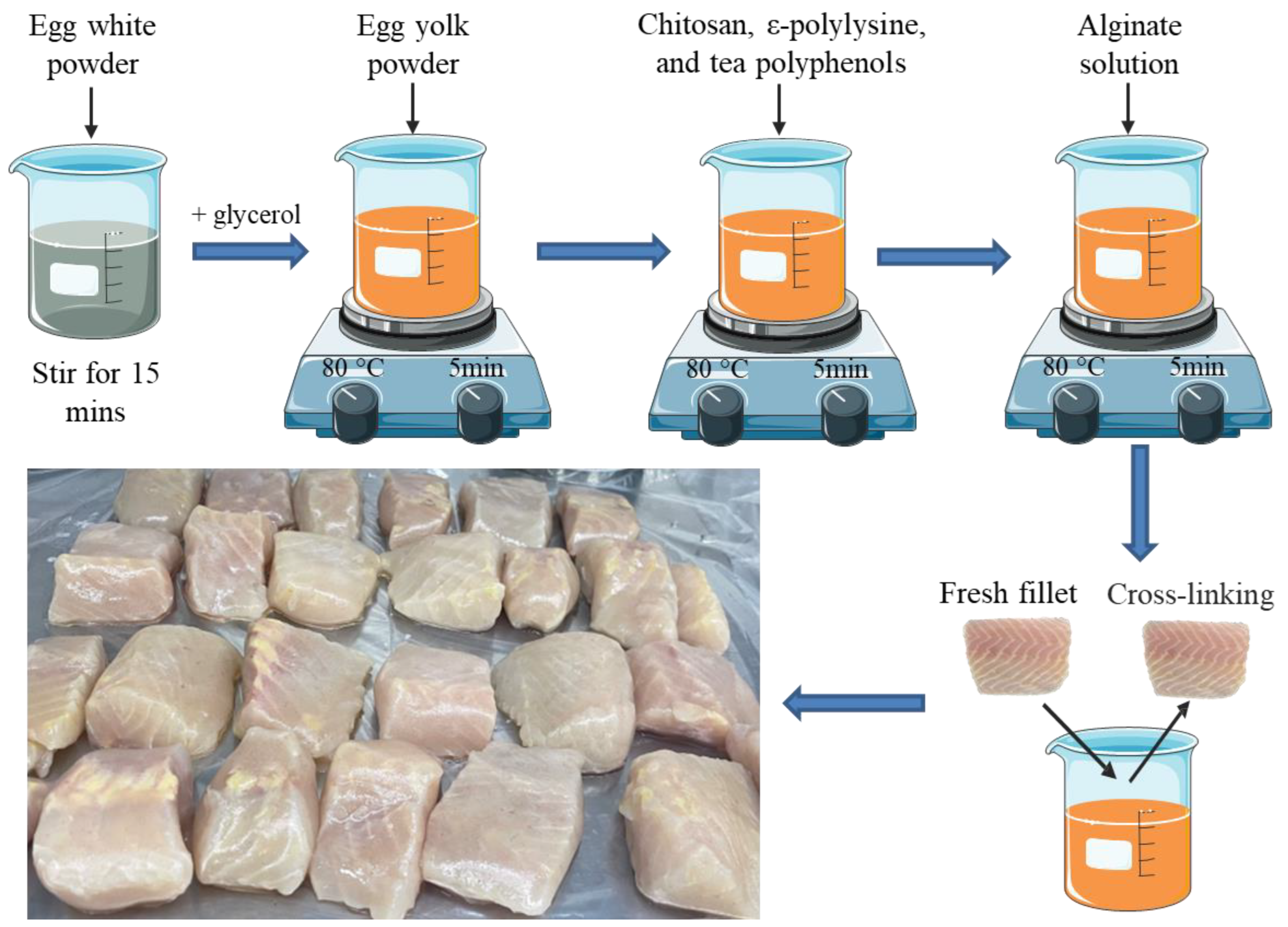
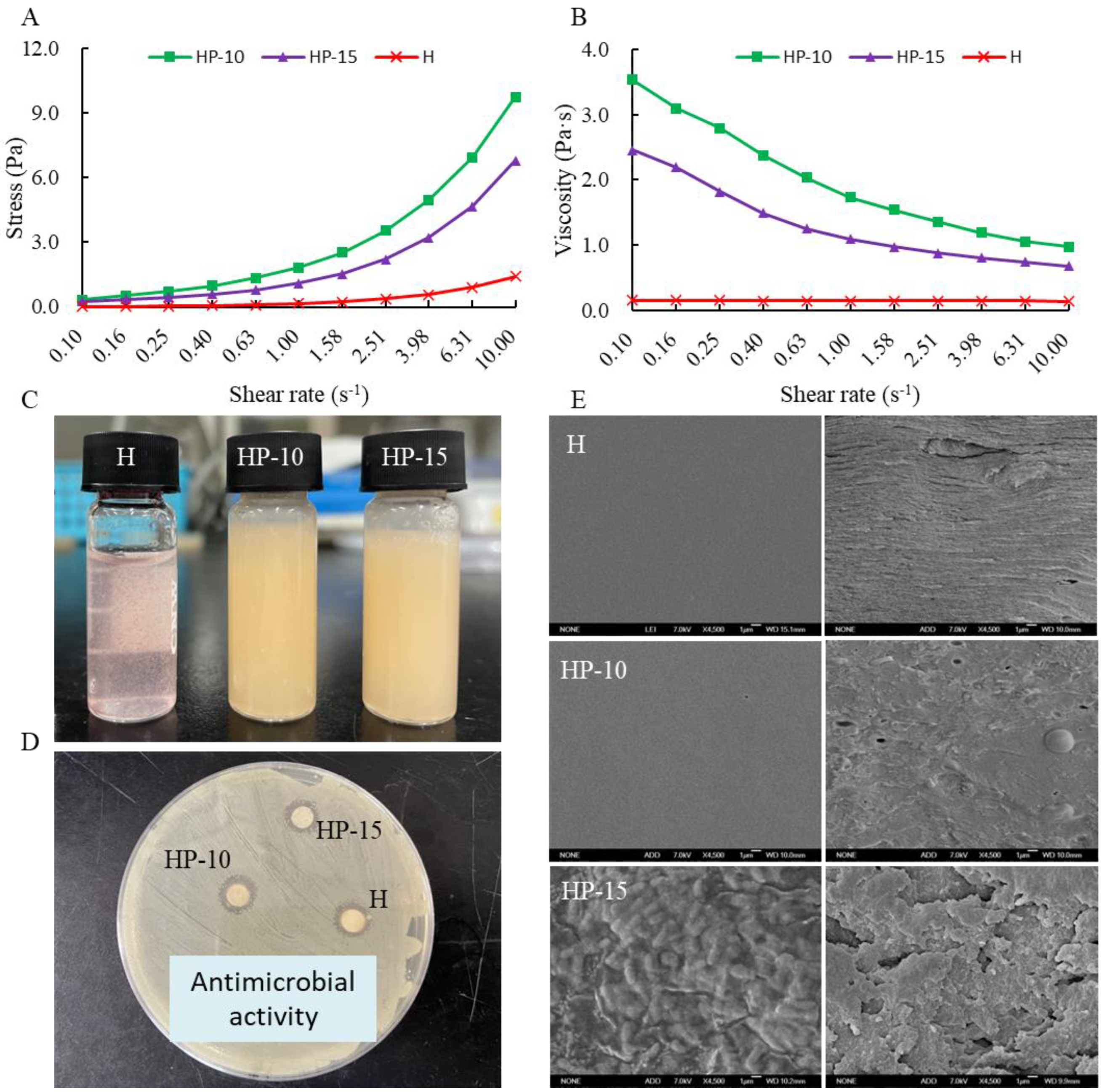
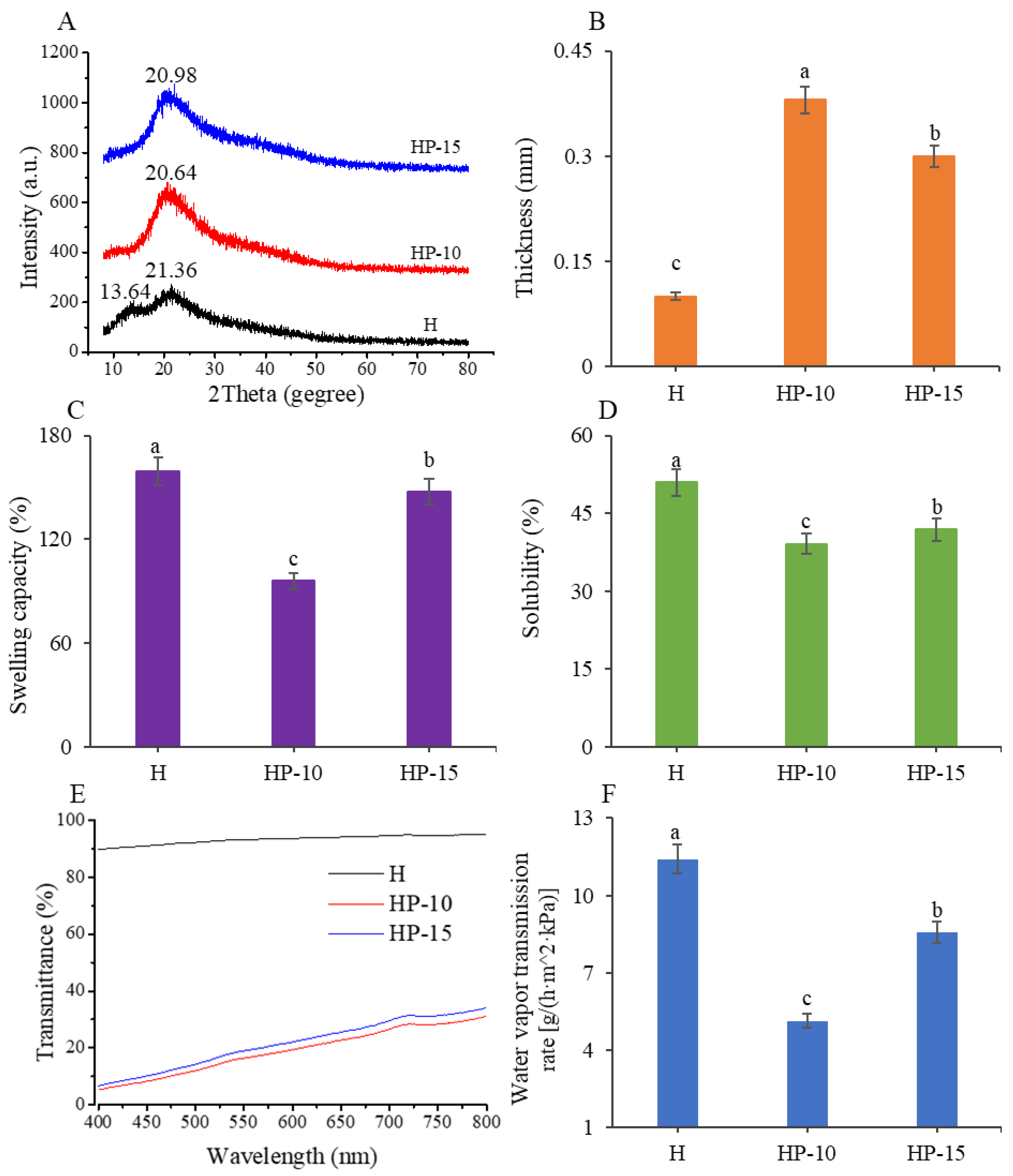
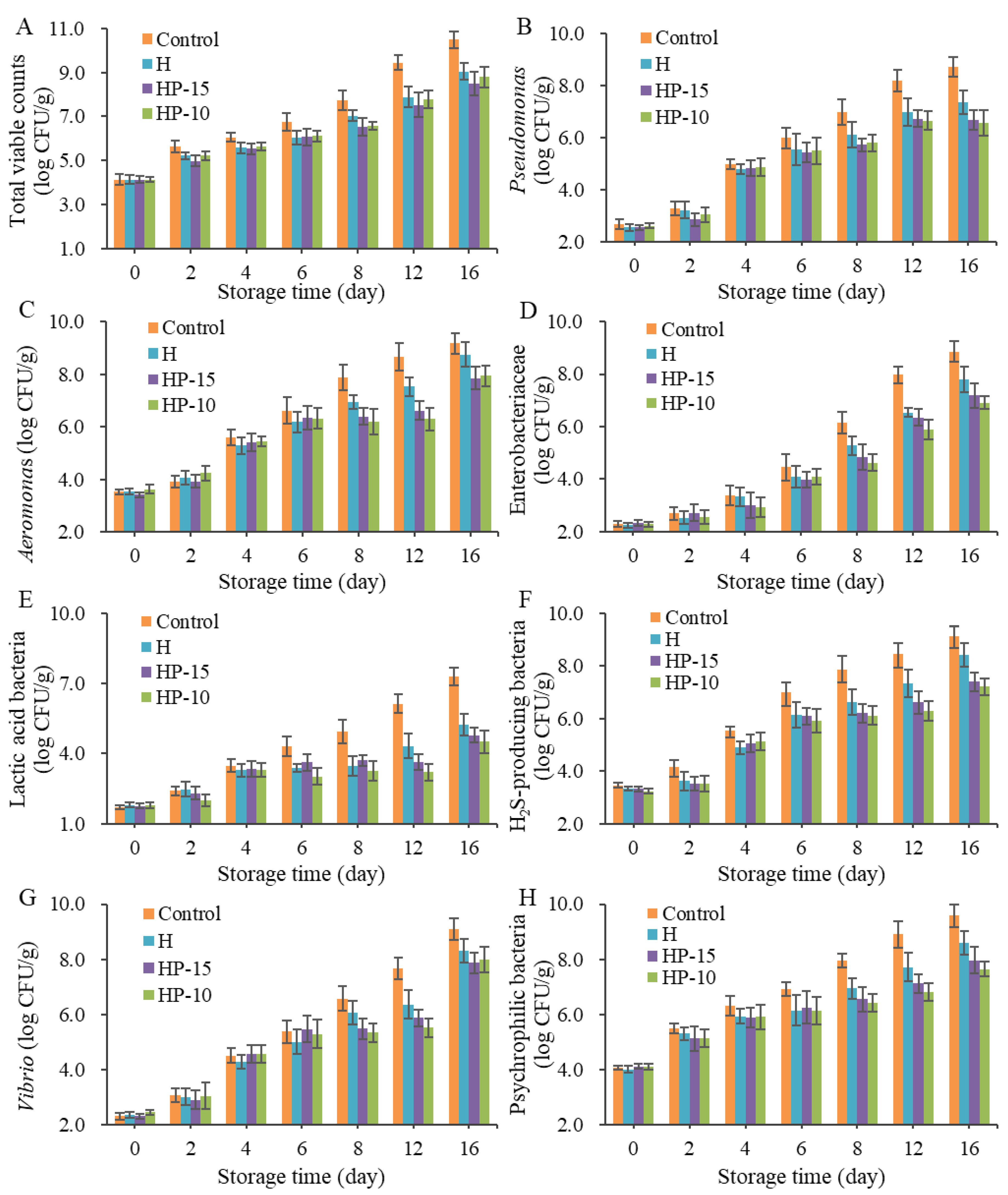
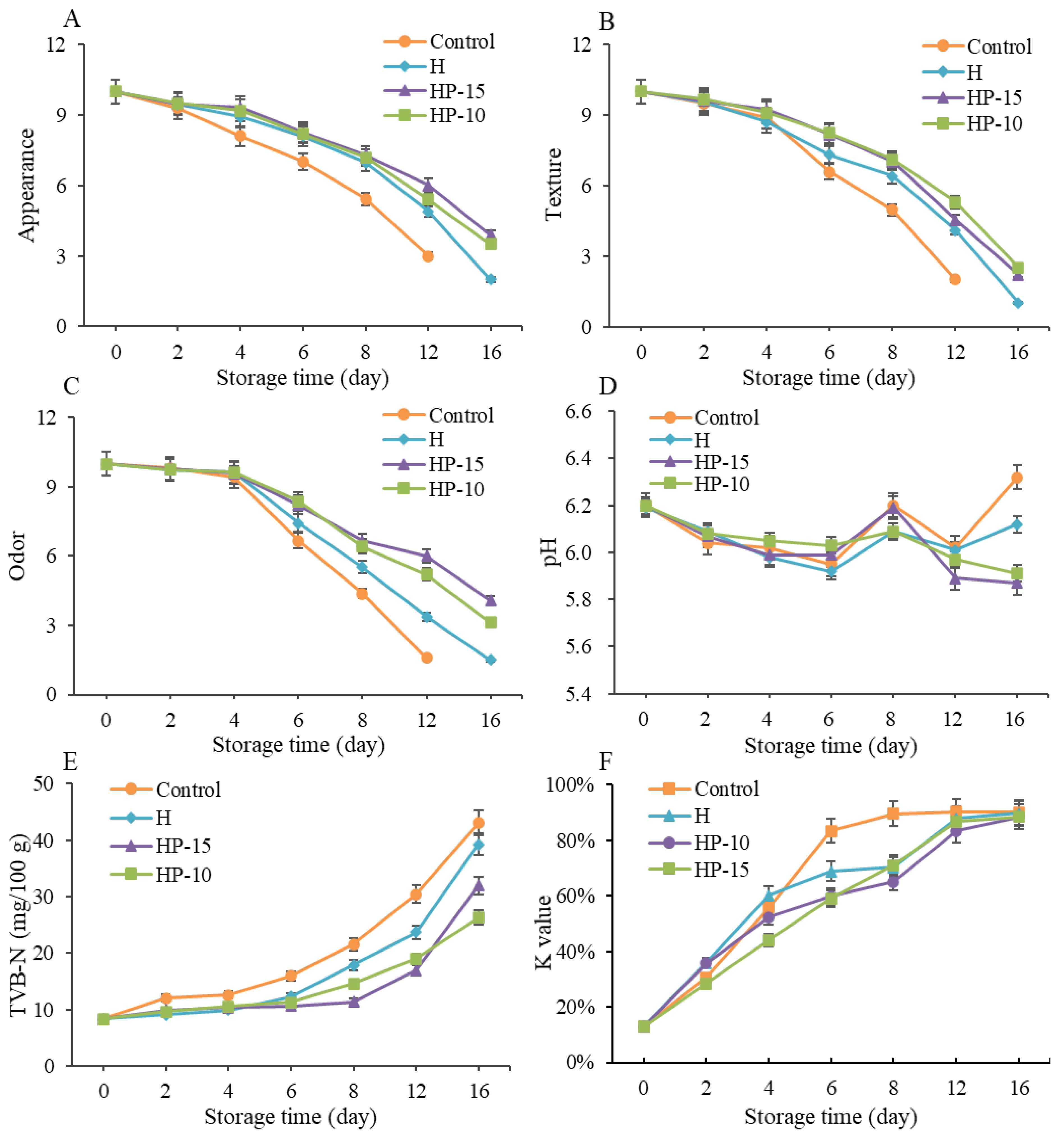
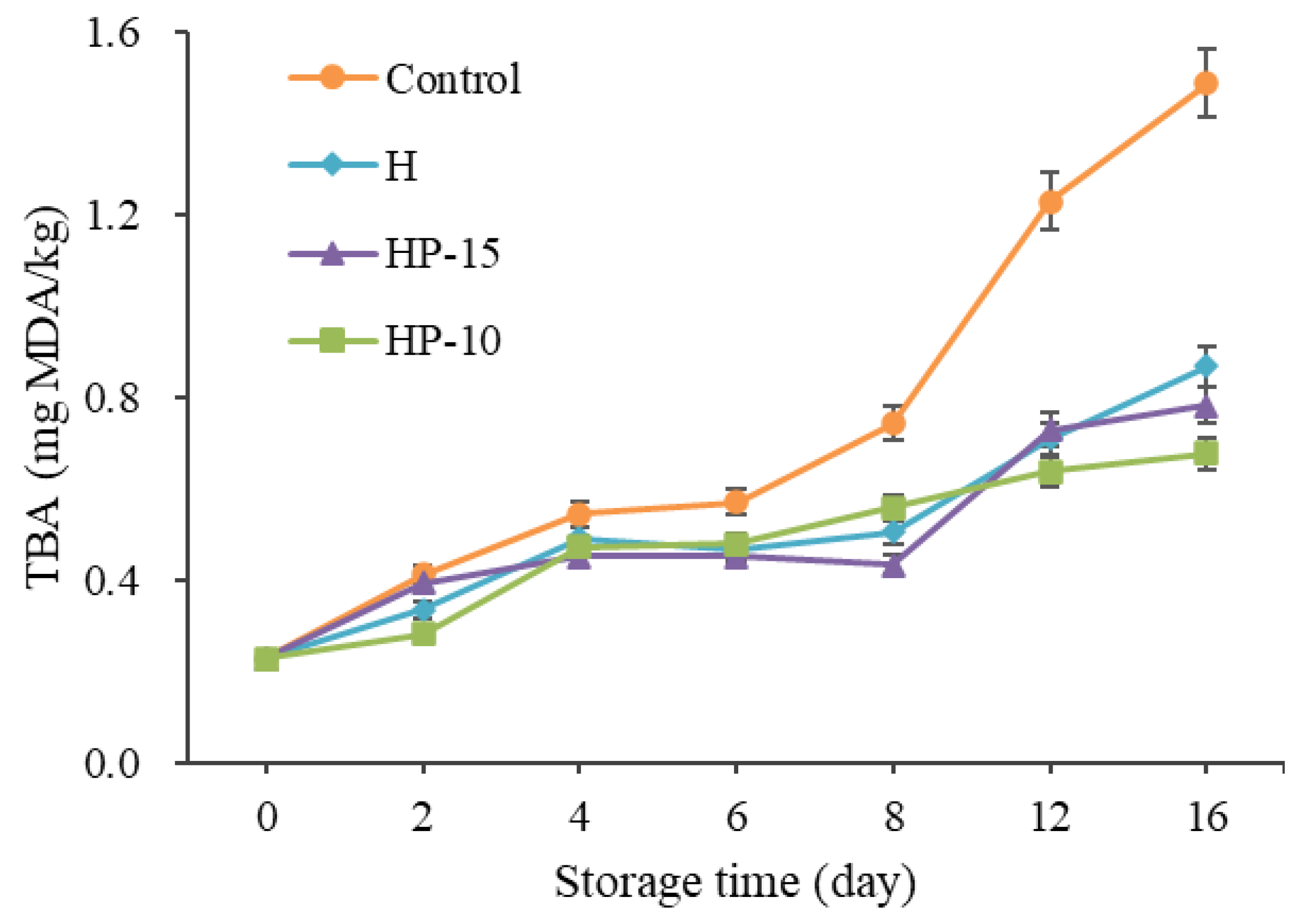
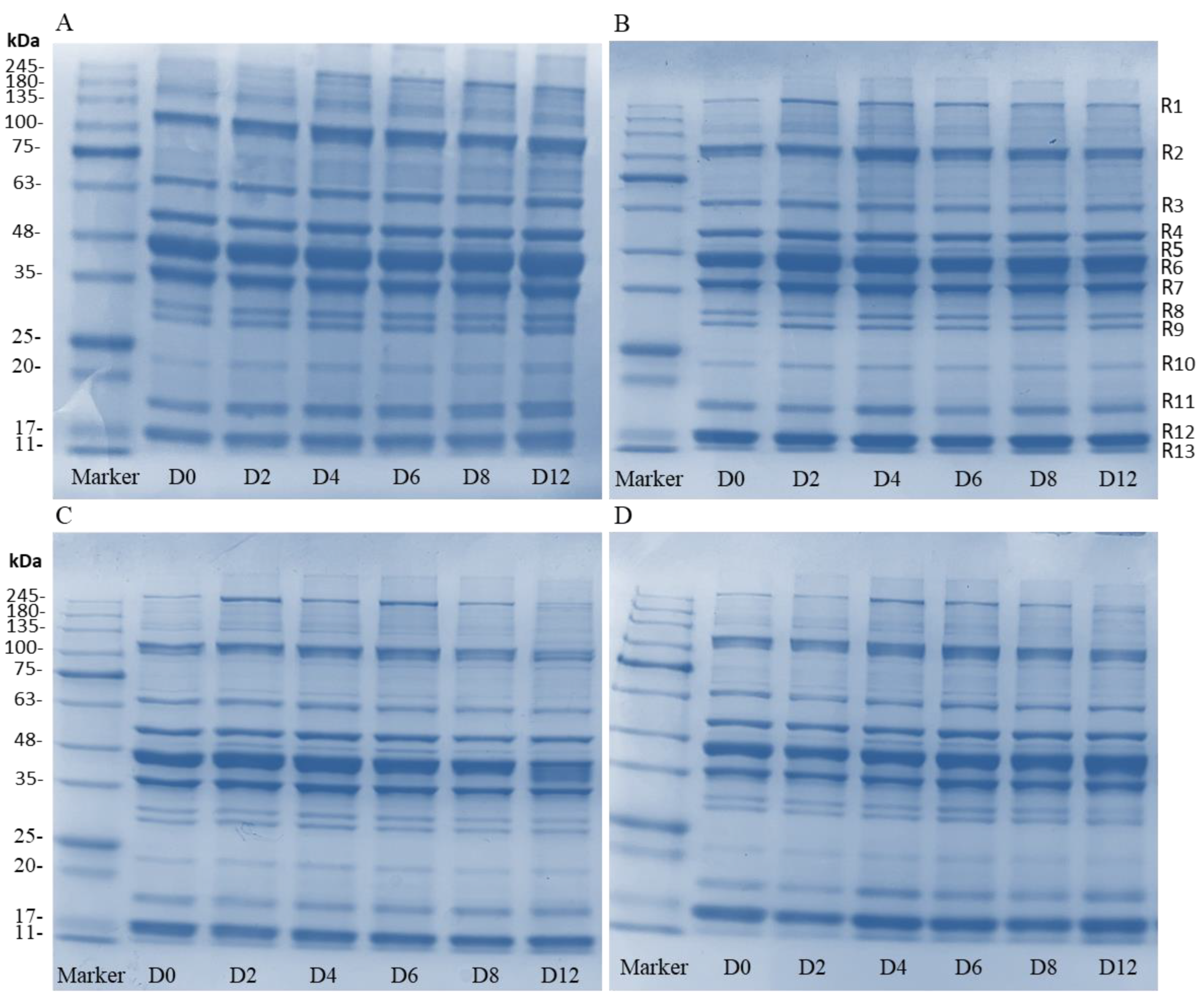
Publisher’s Note: MDPI stays neutral with regard to jurisdictional claims in published maps and institutional affiliations. |
© 2022 by the authors. Licensee MDPI, Basel, Switzerland. This article is an open access article distributed under the terms and conditions of the Creative Commons Attribution (CC BY) license (https://creativecommons.org/licenses/by/4.0/).
Share and Cite
Tan, C.; Pang, D.; Wu, R.; Zou, F.; Zhang, B.; Shang, N.; Li, P. Development of a Multifunctional Edible Coating and Its Preservation Effect on Sturgeon (Acipenser baeri♀× Acipenser schrenckii♂) Fillets during Refrigerated Storage at 4 °C. Foods 2022, 11, 3380. https://doi.org/10.3390/foods11213380
Tan C, Pang D, Wu R, Zou F, Zhang B, Shang N, Li P. Development of a Multifunctional Edible Coating and Its Preservation Effect on Sturgeon (Acipenser baeri♀× Acipenser schrenckii♂) Fillets during Refrigerated Storage at 4 °C. Foods. 2022; 11(21):3380. https://doi.org/10.3390/foods11213380
Chicago/Turabian StyleTan, Chunming, De Pang, Ruiyun Wu, Fanglei Zou, Bo Zhang, Nan Shang, and Pinglan Li. 2022. "Development of a Multifunctional Edible Coating and Its Preservation Effect on Sturgeon (Acipenser baeri♀× Acipenser schrenckii♂) Fillets during Refrigerated Storage at 4 °C" Foods 11, no. 21: 3380. https://doi.org/10.3390/foods11213380
APA StyleTan, C., Pang, D., Wu, R., Zou, F., Zhang, B., Shang, N., & Li, P. (2022). Development of a Multifunctional Edible Coating and Its Preservation Effect on Sturgeon (Acipenser baeri♀× Acipenser schrenckii♂) Fillets during Refrigerated Storage at 4 °C. Foods, 11(21), 3380. https://doi.org/10.3390/foods11213380






